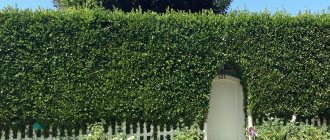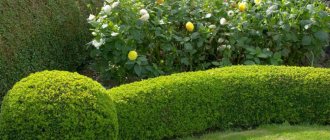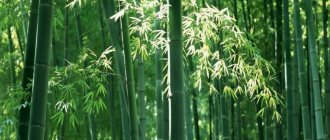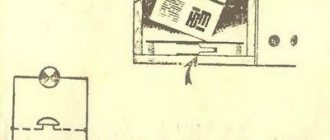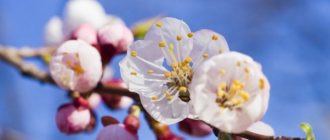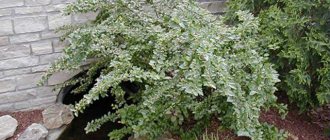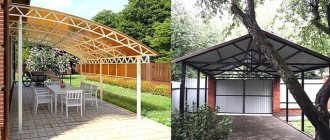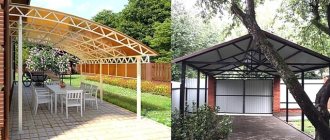In recent years, hedges are increasingly replacing wooden, metal and concrete fences. They can be tall, prickly and completely impenetrable to unwanted visitors.
At the same time, they create beauty and comfort, hide your personal space from prying eyes, promote good air filtration for plants throughout the entire area, and at the same time gently protect them from cold winds and drafts.
Merging with the surrounding landscape, they bring peace and tranquility to the soul. And the starting material for them can be beautifully flowering perennials, ornamental and fruit shrubs, conifers and even vines.
Today there are many examples of hedges that perform a variety of functions. Creating them is not difficult. In this article we will tell you how to make a hedge with your own hands and what plants can be used for this.
The main thing is that you can turn on your imagination and create a real masterpiece that will delight you and your loved ones every day with its grace and fresh beauty!
What is the best way to make a hedge?
It all depends on the function that the hedge fence should perform, the owner’s wallet and personal preferences. Plants can be very different: deciduous or evergreen, climbing or with a straight strong trunk, prickly and smooth, tall and knee-deep, dense and quite loose.
Some can serve their purpose along the border of a plot with neighbors, while others can frame the perimeter of a flower bed. First, decide what you want first. If you want to block your neighbor from looking at you, then the fence should be high and thick. Plants for it can be planted in 2 rows.
When a “live” hedge runs along the border as a picturesque frame, the height is not important. In this case, you need to pay attention to decorative qualities and combination with its closest neighbors. For most, the price tag and unpretentiousness are still important.
It’s up to you to decide which plants are best to choose for a hedge on your property. Take a closer look at the most common ones for this purpose:
- girl's grapes;
- thuja;
- hawthorn;
- spirea;
- rose hip;
- barberry;
- hornbeam;
- privet;
- derain;
- vesicular carp.
Spruce trees planted in a row can also become a kind of hedge, but they grow for a long time, and when they become very large, they will block the yard from the sun Source hvorast.ru When
choosing a plant for your garden, pay attention to what kind of plant it is: evergreen or deciduous. Evergreens most often have a long growth process. In addition, all of them (pines, spruces, larches), except thuja, pose a certain danger when they grow up. The disadvantage of deciduous plants is the loss of their functional characteristics in winter. Many also become very littery with leaves in the fall.
See also: Contacts of companies that specialize in landscape design and gardening.
By region of Russia
Different climatic zones require different shrubs:
In the Moscow region, the following will grow well: thuja "Brabant", bladdercarp, cinquefoil, cherry laurel, brilliant cotoneaster, hawthorn, privet, Alpine currant, deutzia, boxwood, spirea, hydrangea.
For the Leningrad region, the best shrubs for a green fence will be: juniper of all types, blackberries, barberry, hawthorn, viburnum “Snowball”, rose hips, sea buckthorn, sloe, mahonia, privet.
It is best to create a hedge in Siberia from such plantings as:
- Siberian hawthorn,
- Thunberg barberry,
- white derain,
- rose hip,
- gray rose,
- forsythia,
- spirea,
- honeysuckle,
- lilac,
- crown mock orange.
In the Urals you can plant a fence by choosing plants such as
- mahonia,
- red-leaved barberry,
- euonymus,
- spirea,
- spruce,
- turn,
- snowberry,
- hawthorn,
- white derain,
- barberry,
- vesicular carp,
- irga,
- rock juniper.
What shrubs can be used for hedges?
Creating a hedge requires a serious approach. You need to think through everything so that you don’t have to redo it later. In order to isolate yourself from neighbors, not only shrubs, but also climbing plants can be suitable. True, they will require strong support, but they will create a dense mass of leaves.
One of these is girlish grapes. It is unpretentious and grows quickly. And in a few years it will require strict control so that it does not spread throughout the area. If you appear on the site relatively rarely, then this option is unlikely to suit you. It is necessary to plant plants that will not require regular care.
Any bushes require pruning and the formation of a “fence” Source secretgardens.ro
For example, almost any berry bushes are suitable for a hedge in a country house:
- raspberries;
- red, white, golden currants;
- cherry;
- black rowan (chokeberry);
- irga;
- viburnum;
- rose hip;
- hawthorn.
If you want not only to protect your garden from prying eyes and stray animals, but also to harvest useful products, then you should think about creating a hedge of berry bushes. They also need to be trimmed regularly to control height. At the same time, the aesthetics will be preserved, and picking berries will be much more convenient.
Strawberries over a wicker fence - harvesting from such a fence is easier Source houseadvice.ru
The disadvantages of such a fence include the following:
- They cannot be used along the highway as protection against exhaust and dust. Or, as an option, don’t pick berries from such bushes. But we must not forget that others can do this.
- Most of the listed plants produce abundant growth, which is difficult to control, given the length of the site’s boundaries.
- Measures to improve fruiting and high-quality living fencing often contradict each other (thickness, attitude to shoots). Therefore, you have to sacrifice the harvest in order to make a thick and beautiful hedge of bushes.
- Not only you, but also your neighbors will reap the harvest.
If you are going to opt for berry bushes, you need to choose from those listed by height, presence of shoots and thorns. For example, a raspberry will grow about 2 meters, but it produces shoots, which, on the one hand, makes the “fence” denser, and on the other, takes away the strength of the fruiting branches.
You can often see a blackberry hedge in a dacha, but it doesn’t always look perfect, as it grows a lot Source stroypay.ru
Irga will not grow without watering, but if favorable conditions are created, it will produce a lot of berries and good fencing. In addition, it can withstand severe frosts. Rosehip will not grow very quickly, but with the help of thorns it will help protect against uninvited guests and animals. Currants can form dense rows, but their bushes do not grow more than one and a half meters.
Cherry will grow wonderfully in any area, but it will produce abundant growth that will be difficult to control. The disadvantage of viburnum is that it is often damaged by pests. Thus, studying the pros and cons of each plant, you need to choose it “for yourself” so that care does not take much time.
What other plants can you use to make a hedge with your own hands?
When answering the question: what is the best way to make a hedge, you need to remember about shrubs that take a long time to grow but provide a high-quality fence. There are many plants that will grow to the required height in 5-7 years, but will provide an equally high-quality fence.
Green hedge at the dacha made of bushes and trees
Among them there are both shrubs and trees:
- thuja;
- barberry;
- hornbeam;
- blackthorn;
- hazel;
- euonymus;
- honeysuckle.
Pay attention to barberry. This is not to say that it grows quickly, but at the same time it produces a 2-meter impenetrable hedge with huge thorns. It does not sprout, and in the fall it pleases the eye with purple foliage and an abundance of berries. Barberry thunberga Atropurpurea has red foliage all season.
The barberry bush with red leaves does not need to be decorated with flowers or berries - it already looks beautiful Source mirlandshaft.ru
Evergreens for hedges
Many people prefer to have a hedge made of coniferous plants. These are spruce, thuja, and pine trees. The latter are growing very quickly. But they are suitable for fencing only in exceptional cases, given the size to which they grow. Evergreen plants have one significant advantage - they are decorative all year round and purify the air even in winter.
Larch is often included in this group. But this is a mistake, since it is a deciduous tree. Currently, thuja is used in ornamental gardening and as a fence. It is relatively unpretentious and frost-resistant. But thuja grows for quite a long time.
Shrubs that do not require regular trimming
Among the shrubs that are good even without cutting, one can name Kalmia. Blooms beautifully with lush flowers. An evergreen plant with amazing flowering.
Spiraea Vangutta is covered with white flowers in spring. Grows quickly in any soil, in the shade or in the sun.
Caragana with golden flowers is often chosen for planting in uneven areas. Grows in any soil and does not require careful care.
Undesirable plants for perennial hedges
It’s a matter of taste, but most often plants that, despite all efforts, fill the garden and vegetable garden with root shoots are undesirable. The most famous in this group will be the Sakhalin knotweed. It creates a beautiful hedge, but produces a huge number of offspring.
Trees that are difficult to form are undesirable as hedges. If the distance between the plants and the main garden is small, then there is no need to plant birch trees, whose roots resemble pumps in their ability to draw moisture around. This will harm nearby plants.
Interesting Facts
Hedges have existed since ancient times. Back then they were created mainly from flowers. In the Middle Ages, hedges were used to decorate palace grounds. Later, they began to be widely used by nobles, merchants, and townspeople.
Those who independently mastered the art of creating green fences, acquiring the profession of gardener, were held in high esteem. So in Europe they began to hold competitions for the title of best gardener.
The winner received the opportunity to work at the royal court. The most beautiful hedge in Europe is considered to be the territory of Versailles, where a variety of plants are collected.
Trimming and trimming hedges
To make it easier to care for plants, they are cut to an accessible height of 2-3 meters using special pruning shears with long handles and powerful blades that can “cut through” medium branches. A bush or tree should be inspected annually in the spring and adjustments made: thick, old and withered branches should be completely cut out.
Pruning plants requires knowledge; an incorrect approach to the formation of bushes can lead to plant death Source garshinka.ru
Shrubs are formed by cutting 2-3 times per season, as necessary. In this case, you need to remove 10-15 cm of growth at a time. This way, the plants will retain their shape and grow thicker. Willow can be cut more often, thujas and other evergreens - it is enough to “pass” with pruning shears 2 times a year.

